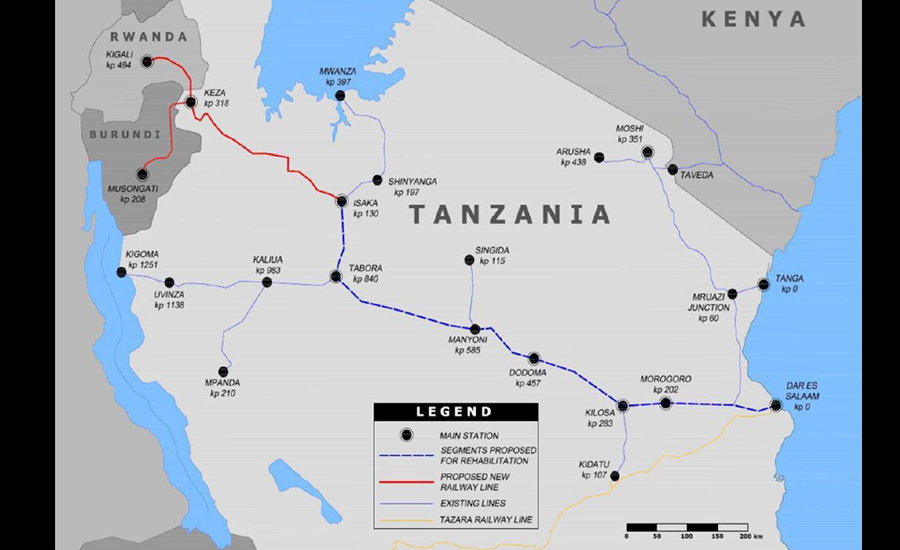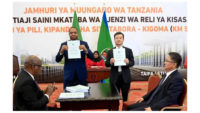The planned construction of a 1,661-kilometer-long, standard-gauge railway line linking Tanzania with neighboring Rwanda and Burundi has moved a step forward after China’s Export-Import Bank agreed on July 20 to provide $7.6B for the project.
Gerson Msigwa, spokesperson for the Tanzanian presidency, said in a media statement that the concessional loan will be released after the Chinese EXIM Bank and Tanzania finishes settling technical details on the financing. No details were provided on the terms and conditions of the loan, what components it will finance and what share of the project cost will be shouldered by Tanzania.
The announcement was made on the same day that Tanzania’s President John Magufuli held discussions with EXIM Bank President Liu Liange in the country’s administrative capital of Dodoma.
In June, Tanzania’s Finance minister Philip Mpango announced the government has allocated $1.13B for the project, plus an additional $73 million for the rehabilitation of the 1,254-km-long, meter-gauge central railway line, as well as the procurement of additional locomotives and wagons.
The standard-gauge line route parallels an existing narrow-gauge line between Dar es Salaam and Isaka, and then a new line continues to Keza before dividing into lines, one to Burundi and one to Rwanda. According to a project brief, “in some locations it will be constructed with the right-of-way of existing line.”
Last March Tanzania, Rwanda and Burundi, through Rwanda’s Transport Development Agency, shortlisted 13 bidders that responded to the expression of interest issued in August 2015 for the financing, design, construction, operation and maintenance of the standard gauge railway line under a public private partnership model.
The railway line will run from Dar es Salaam to Isaka (970 km), Isaka to Kigali, Rwanda (494 km) and Keza to Musongati via Gitega in Burundi (197 km).
The shortlisted contractors include Chinese companies China Railway Group, a consortium led by Sinohydro Corp. Ltd in partnership with China Railway Materials Co. Ltd (CRM) and Beijing National Railway Research & Design Institute of Signal & Communication Group Co. Ltd (CRSCD), China Communications Construction Co. and China Civil Engineering Construction Corp. Other bidders came from France, Germany, Turkey, Portugal and South Africa. The winning contractor is yet to be announced.
A project brief by Montreal-based Canarail, which did the second feasibility study on the standard-gauge railway, says the line will mainly operate freight trains with heavy permissible axle loads of 32.4 tons. The trains, which will be 2,000m long, will handle up to 8.5 MTPA by 2029 according to the brief.
Canarail said freight operations “are expected to be profitable, but it is anticipated that passenger operations will require a form of subsidy or Passenger Service Obligation (PSO) payment.”
According to the project brief, the single track line will consist of ballasted track with heavy rail (70kg/m) and pre-stressed concrete sleepers with elastic fasteners. Signals and controls will consist of centralized traffic control, computer-based interlocking, automatic train protection and a fiber-optic communications backbone. The planned railway’s telecommunication system will use GSM-R for both data and voice communications between drivers, control center, stations and maintenance crews.
Rwanda, one of the three countries involved in the standard-gauge line project, also is developing another, similar railway project with Uganda and Kenya as part of the Northern Corridor Integration Projects to improve efficiency of freight transport from the port of Mombasa in Kenya to landlocked Uganda and Rwanda.
The first phase of Kenya’s 609-km line, financed 90% by China EXIM Bank, from Mombasa to the capital Nairobi, is now more than 70% complete under a $3.8B contract by China Roads and Bridge Corp., a subsidiary of China Communication Construction Co.
In March, Kenya, through the state-run railway operator, Kenya Railways Corp., signed a $5.4B contract with the China Communications Construction Co. for the construction of the next phase from Naivasha, 76 km west of the capital Nairobi, to the Kenya-Uganda border town of Malaba.
Uganda had in the first quarter of this year awarded an EPC contract to China Harbour Engineering Co. Ltd, for the construction of the 238-km track from Malaba to the capital Kampala.



Post a comment to this article
Report Abusive Comment